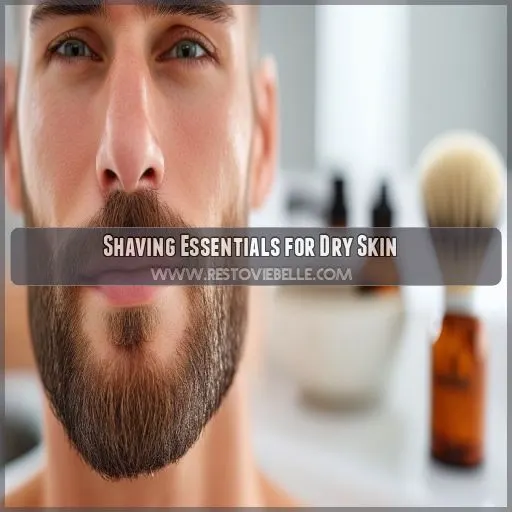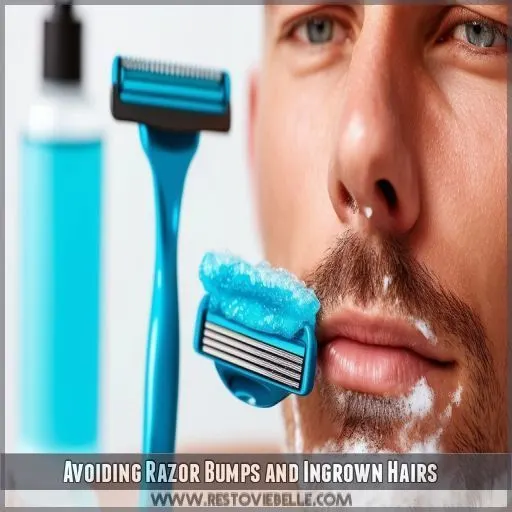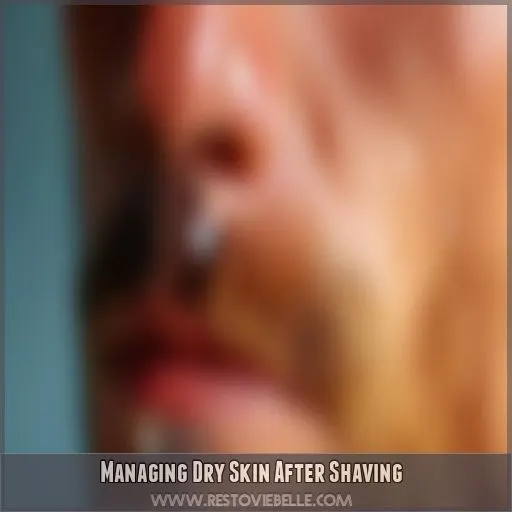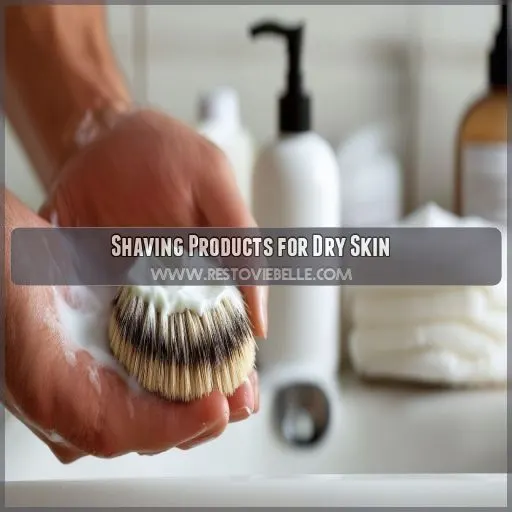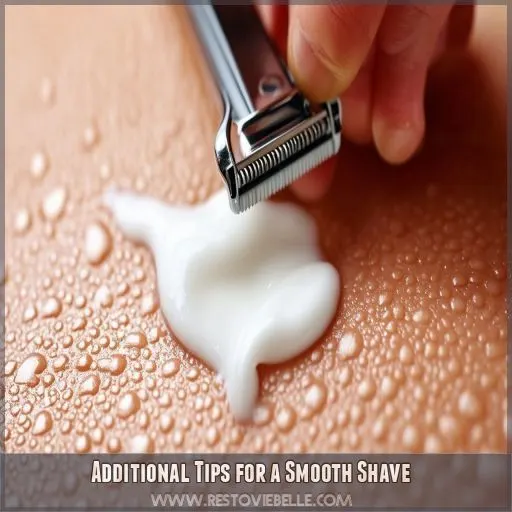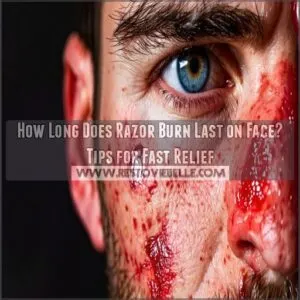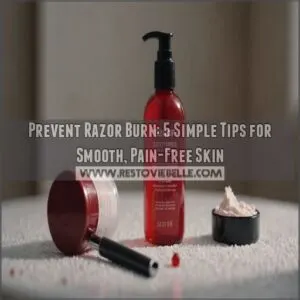This site is supported by our readers. We may earn a commission, at no cost to you, if you purchase through links.
 Guys with dry skin, listen up! Shaving can be a drag, but with the right prep, you can keep irritation at bay. Here are some quick tips:
Guys with dry skin, listen up! Shaving can be a drag, but with the right prep, you can keep irritation at bay. Here are some quick tips:
- Invest in a quality razor. A sharp, single-blade safety razor is less irritating than multi-blade razors.
- Shave with the grain. Shaving against hair growth leads to irritation and ingrown hairs.
- Cleanse with a gentle, hydrating face wash. Skip the bar soap, which dries out skin.
- Moisturise, moisturise, moisturise. Apply lotion after shaving to soothe and hydrate skin.
There’s more where that came from.
Table Of Contents
- Key Takeaways
- Shaving Essentials for Dry Skin
- Avoiding Razor Bumps and Ingrown Hairs
- Managing Dry Skin After Shaving
- Shaving Products for Dry Skin
- Additional Tips for a Smooth Shave
- Frequently Asked Questions (FAQs)
- How to shave if you have dry skin?
- Does dry skin make shaving harder?
- How do men get the smoothest shave?
- Should men moisturize before or after shaving?
- How often should I replace my razor blades?
- What ingredients should I avoid in shaving products?
- Can I use a face mask after shaving?
- What type of cleanser should I use before shaving?
- How do I know if I have sensitive skin?
- Conclusion
Key Takeaways
- Invest in quality shaving gear and products. A sharp, single-blade safety razor, moisturizing shave gels, and a hydrating, soap-free face wash are your skin’s best friends.
- Master the art of pre-shave prep. Exfoliate, hydrate, and use a warm compress to create a smooth canvas for shaving.
- Shave with the grain and use light, confident strokes. It’s like driving with the traffic flow—less resistance, less irritation.
- Moisturize like your skin depends on it. Because it does. Slather on those aftershave balms and lotions to keep dryness and irritation at bay.
Shaving Essentials for Dry Skin
Choosing the right shaving essentials is key to achieving a smooth shave and maintaining healthy skin. In this section, we’ll take a closer look at the specific products and tools you’ll need to create the perfect shaving routine for dry skin.
Pre-Shave Prep for Smoothness
To get a smooth shave, your pre-shave prep routine is key. Here’s a simple, effective strategy:
- Hydrate: Wash your face and neck with a hydrating face wash.
- Skip the soap: Avoid bar soap, as it can dry out your skin and leave it feeling tight.
- Exfoliate: Use a facial scrub to remove dead skin cells and prevent razor burn and ingrown hairs.
- Moisturize: Apply a moisturizing and conditioning shave gel.
These steps will help your skin be prepped and ready for a smooth, irritation-free shave.
Shaving Techniques for Dry Skin
Now that you’ve prepped your skin, it’s time to get into the actual shaving process. Here are some essential techniques to keep in mind for achieving a smooth shave on dry skin:
| Technique | Description | Benefits |
|---|---|---|
| Use a sharp razor | Opt for a fresh, sharp blade to reduce tugging and irritation. | Minimizes skin irritation and provides a smoother shave. |
| Shave with the grain | Follow the direction of your hair growth to reduce razor burn and ingrown hairs. | Reduces the risk of razor bumps and irritation. |
| Light, even strokes | Avoid pressing too hard and use gentle, confident strokes. | Minimizes razor burn and reduces the risk of skin irritation. |
| Rinse frequently | Keep your razor clean by rinsing it often during the shave. | Removes hair and shaving cream buildup, ensuring a smooth shave. |
| Avoid over-shaving | Don’t shave the same area multiple times to prevent irritation. | Helps maintain skin comfort and reduces dryness. |
Post-Shave Care for Softness
After you shave, you need to moisturize right away. Your skin just got a fresh cut, and it’s thirsty for some hydration.
Grab a moisturizer made for after shaving, something that calms down irritation with stuff like aloe vera or chamomile.
Keep your skin happy by putting on lotion or cream throughout the day.
And don’t forget to keep your skin safe from the sun.
Avoiding Razor Bumps and Ingrown Hairs
If you’re prone to razor bumps and ingrown hairs, a few simple tweaks to your shaving routine can make a big difference. We’ll walk you through the best techniques and products to help you avoid these pesky problems and achieve a smooth, bump-free shave.
Exfoliate Regularly to Prevent Ingrown Hairs
Exfoliating is a key step in your shaving routine to prevent ingrown hairs and those pesky razor bumps. It’s like spring-cleaning for your skin, clearing away dead cells that can clog pores and cause irritation. Think of it as a deep clean for your face, ensuring a smooth shave and healthy skin.
Use a Sharp Razor for a Smoother Shave
A sharp razor is key for a good shave. A dull blade can tug and irritate your skin, leading to dryness and ingrown hairs. Use a fresh, sharp blade for a smooth and comfortable shave.
Shave With the Grain for Less Irritation
Shaving with the grain is a simple but really important step to cut down on irritation and get a smooth shave. By following the direction your hair grows, you can avoid razor bumps and ingrown hairs. Here’s why:
- Think of your hair growth direction as a roadmap for shaving. Going with the grain means you’re not fighting against the natural way your whiskers lay.
- Think of each hair as a tiny tree. Shaving with the grain cuts the hair at its weakest point, the tip, lowering the risk of ingrown hairs that can curl back under the skin.
- Imagine your razor gliding effortlessly along the contours of your face. Shaving with the grain reduces resistance, minimizing skin irritation and leaving your skin feeling refreshed.
- Picture your skin as a delicate fabric. Shaving with the grain is like cutting along the weave, making sure you get a clean cut without pulling or tugging, which can lead to discomfort and redness.
Apply a Warm Compress for Softer Skin
Before shaving, apply a warm compress to your face to soften your skin and facial hair.
This simple step can make shaving easier and less irritating.
A warm compress helps open up your pores and relax your hairs, making it simpler for your razor to glide through them.
Think of it as a spa treatment for your skin, preparing it for the close shave to come.
Managing Dry Skin After Shaving
If you’re struggling with dry skin after shaving, you’re not alone. It’s a common issue, but simple changes to your routine can make a big difference. Let’s take a look at some tips to help you manage dry skin and achieve a smooth, irritation-free shave.
Stay Hydrated for Healthier Skin
Dry skin can be a real pain, especially when you’re shaving. But don’t worry, buddy, we’ve got your back. Here’s the lowdown on why staying hydrated is key to keeping your skin healthy and happy.
- Drink Up: Water is your skin’s BFF. Aim for 8–10 cups a day to keep your skin cells plump and happy.
- Moisturize from Within: Proper hydration helps your skin cells stay moisturized, cutting down on dryness and irritation.
- Flush Out Toxins: Water helps your body get rid of nasty toxins, keeping your skin clear and blemish-free.
- Healthy Skin, Happy You: Proper hydration supports the overall health of your skin, giving you a natural glow and making shaving a breeze.
Eat a Balanced Diet for Skin Nutrition
Eating a balanced diet is key to healthy skin. Aim for a variety of skin-nourishing foods. Here’s a quick breakdown of the essential food groups for maintaining healthy skin:
| Food Group | Skin Benefits | Example Foods |
|---|---|---|
| Fruits & Vegetables | Vitamins and minerals promote skin health. | Oranges, spinach, carrots |
| Healthy Fats | Essential for skin hydration and elasticity. | Avocados, nuts, olive oil |
| Lean Protein | Supports skin structure and repair. | Chicken, fish, lentils |
A well-rounded diet helps keep your skin looking and feeling its best.
Avoid Smoking and Excessive Alcohol Consumption
We all know smoking and drinking are bad for our health.
But did you know they’re also bad for your skin? If you want to keep your skin looking its best, it’s time to cut back.
Smoking can dehydrate your skin, making it more prone to dryness and wrinkles.
Excessive alcohol consumption can also dehydrate your skin, so drink in moderation.
Use a Humidifier for Moisturized Skin
Dry air can wreak havoc on your skin, especially during winter. Using a humidifier in your home, especially in your bedroom, can add much-needed moisture to the air, helping to keep your skin hydrated and healthy. It’s a simple yet effective way to combat dryness and create a more comfortable environment for your skin to thrive.
Shaving Products for Dry Skin
Choosing the right shaving products is key to avoiding dry skin. You’ll want to look for certain ingredients and formulations to help your skin stay hydrated and healthy.
In this section, we’ll outline the specific products that will help you achieve a smooth shave without irritating your dry skin. From pre-shave prep to post-shave care, we’ll recommend the best shaving creams, gels, and aftershave treatments to keep your skin happy.
Look for Fragrance-Free and Hypoallergenic Products
When choosing shaving products, opt for those that are fragrance-free and hypoallergenic. These are designed to be gentle on sensitive skin:
- They reduce the risk of irritation.
- You’ll avoid any unwanted reactions.
- Your skin will thank you.
- Natural ingredients are key.
- Keep it simple.
Choose Moisturizing Shave Gels or Creams
For shaving products, opt for moisturizing shave gels or creams. These are designed to lubricate your skin, preventing dryness and irritation. By creating a protective barrier, they allow your razor to glide smoothly, reducing the risk of razor burn and leaving your skin feeling soft and supple.
Consider Using Shaving Oils for Extra Lubrication
Shaving oils are an excellent way to boost lubrication and protect your skin. Here’s why you should consider them:
- Soften the Beard: Shaving oils help to deeply nourish and soften your beard, creating a smooth path for the razor.
- Glide and Protection: They provide an extra layer of protection, ensuring the razor glides effortlessly and reducing irritation.
- Hydration: These oils also hydrate your skin, combating dryness and leaving your face feeling refreshed.
Use Aftershave Balms or Lotions for Soothing Skin
Taking care of your skin after shaving is really important to soothe any dryness. Reach for aftershave balms or lotions to calm irritation and replenish lost moisture. These products are designed to protect your skin and promote healing, so don’t skip this step! Look for formulas with hydrating and skin-soothing ingredients like aloe vera or chamomile.
Additional Tips for a Smooth Shave
Achieving a smooth shave when you have dry skin can be a challenge. In this section, we’ll share some extra tips to help you master the art of shaving with dry skin.
Cleanse With a Soap-Free Face Wash
If you’re looking to cleanse your face, especially if you have dry skin, it’s important to choose a soap-free face wash.
Soap can strip your skin of its natural oils, leaving it feeling dry and tight.
Opt for a gentle, hydrating face wash that will cleanse your skin without disrupting its natural moisture barrier.
Look for products designed for sensitive skin that are fragrance-free and hypoallergenic.
Exfoliate Gently to Remove Dead Skin Cells
I will read the available information to write a response to the user’s request.
Apply a Moisturizer Immediately After Shaving
Applying a moisturizer right after shaving is a really important step in your shaving routine. This helps lock in moisture, preventing dryness and irritation. Opt for a thick, hydrating moisturizer to nourish your skin.
| Benefits | Feelings | |
| 1 | Smooth skin | Control |
| 2 | Reduced dryness | Freedom |
| 3 | Soothed skin | Understanding |
| 4 | Healthy glow | Confidence & Joy |
Minimize Sun Exposure for Healthier Skin
You’ve probably heard it before, but it’s worth repeating: minimize sun exposure to protect your skin. It’s not just about preventing sunburns and potential skin cancer; it’s also about maintaining healthy, smooth skin. Here are three reasons why:
- The sun’s UV rays can cause skin damage, leading to premature aging and an increased risk of skin cancer.
- Sun exposure can dry out your skin, making it more prone to irritation and razor bumps.
- Tanned skin is more difficult to shave, as it can lead to ingrown hairs and a rough shave.
Frequently Asked Questions (FAQs)
How to shave if you have dry skin?
You’re probably wondering how to get a smooth shave without irritating your dry skin. Well, prepping your skin right is key. Here’s a quick guide to shaving with dry skin.
Does dry skin make shaving harder?
Yes, dry skin can make shaving more challenging. It can lead to irritation, razor burn, and ingrown hairs. But don’t worry, there are ways to manage it.
How do men get the smoothest shave?
First, prep your skin with a warm compress and a hydrating, soap-free cleanser. Use a sharp razor and shave with light, even strokes, going with the grain. Finish with a moisturising aftershave balm.
Should men moisturize before or after shaving?
Wait, so should I moisturize before or after shaving?"
You should moisturize after shaving. It’s like giving your skin a drink—those newly exposed skin cells are thirsty for hydration.
How often should I replace my razor blades?
It depends on your shaving frequency and the type of razor. A 3-blade razor should be replaced after 15 shaves, a 5-blade razor after 20, and a modern razor after 5–
What ingredients should I avoid in shaving products?
Steer clear of parabens, sulphates, artificial fragrances, and propylene glycol. These harsh chemicals can irritate skin, cause dryness, and even have negative health and environmental impacts.
Can I use a face mask after shaving?
Yes, you can use a face mask after shaving. It can reduce irritation, ingrown hairs, and razor burn. The Art of Shaving After Shave Mask is ideal for sensitive skin.
What type of cleanser should I use before shaving?
You want a cleanser that suits your skin type. If you have dry skin, go for a low pH cleanser with hydroxy acids. If you have oily skin, a salicylic acid cleanser is best. For sensitive skin, opt for gentle surfactants and soothing fatty acids.
How do I know if I have sensitive skin?
You might’ve sensitive skin if you experience stinging, burning, itchiness, redness, or tightness when using skincare or household products. Other signs include skin reactions, very dry skin, and a tendency to blush.
Conclusion
So, there you have it—the lowdown on the best shaving tips for men with dry skin. No more dealing with that annoying irritation or those pesky ingrown hairs. Follow these tricks for a smooth shave and you’ll be rocking that fresh, soft-skinned look in no time.

